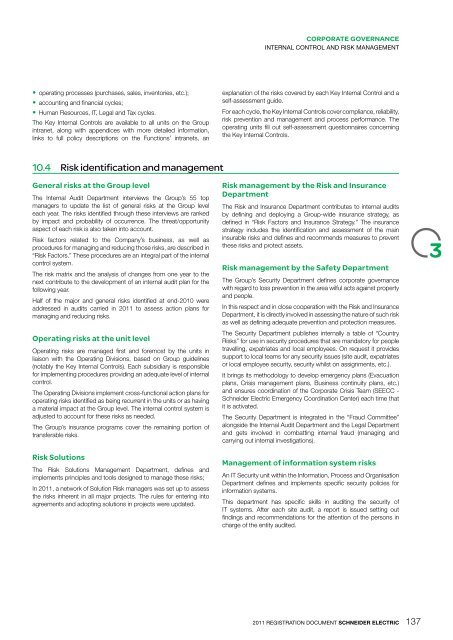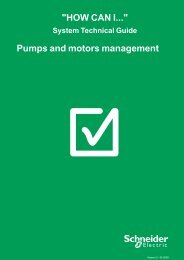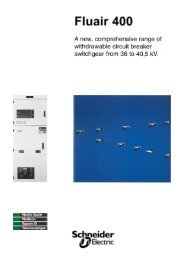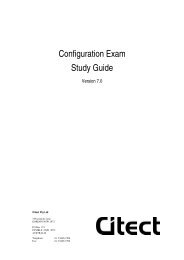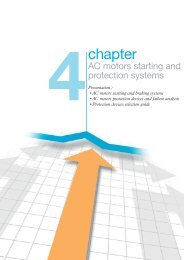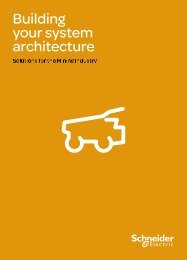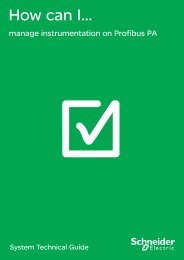Connect - Schneider Electric
Connect - Schneider Electric
Connect - Schneider Electric
Create successful ePaper yourself
Turn your PDF publications into a flip-book with our unique Google optimized e-Paper software.
• operating processes (purchases, sales, inventories, etc.);<br />
• accounting and fi nancial cycles;<br />
• Human Resources, IT, Legal and Tax cycles.<br />
The Key Internal Controls are available to all units on the Group<br />
intranet, along with appendices with more detailed information,<br />
links to full policy descriptions on the Functions’ intranets, an<br />
10.4 Risk identification and management<br />
General risks at the Group level<br />
The Internal Audit Department interviews the Group’s 55 top<br />
managers to update the list of general risks at the Group level<br />
each year. The risks identifi ed through these interviews are ranked<br />
by impact and probability of occurrence. The threat/opportunity<br />
aspect of each risk is also taken into account.<br />
Risk factors related to the Company’s business, as well as<br />
procedures for managing and reducing those risks, are described in<br />
“Risk Factors.” These procedures are an integral part of the internal<br />
control system.<br />
The risk matrix and the analysis of changes from one year to the<br />
next contribute to the development of an internal audit plan for the<br />
following year.<br />
Half of the major and general risks identifi ed at end-2010 were<br />
addressed in audits carried in 2011 to assess action plans for<br />
managing and reducing risks.<br />
Operating risks at the unit level<br />
Operating risks are managed fi rst and foremost by the units in<br />
liaison with the Operating Divisions, based on Group guidelines<br />
(notably the Key Internal Controls). Each subsidiary is responsible<br />
for implementing procedures providing an adequate level of internal<br />
control.<br />
The Operating Divisions implement cross-functional action plans for<br />
operating risks identifi ed as being recurrent in the units or as having<br />
a material impact at the Group level. The internal control system is<br />
adjusted to account for these risks as needed.<br />
The Group’s insurance programs cover the remaining portion of<br />
transferable risks.<br />
Risk Solutions<br />
The Risk Solutions Management Department , defi nes and<br />
implements principles and tools designed to manage these risks;<br />
In 2011, a network of Solution Risk managers was set up to assess<br />
the risks inherent in all major projects. The rules for entering into<br />
agreements and adopting solutions in projects were updated.<br />
CORPORATE GOVERNANCE<br />
INTERNAL CONTROL AND RISK MANAGEMENT<br />
explanation of the risks covered by each Key Internal Control and a<br />
self-assessment guide.<br />
For each cycle, the Key Internal Controls cover compliance, reliability,<br />
risk prevention and management and process performance. The<br />
operating units fi ll out self-assessment questionnaires concerning<br />
the Key Internal Controls.<br />
Risk management by the Risk and Insurance<br />
Department<br />
The Risk and Insurance Department contributes to internal audits<br />
by defi ning and deploying a Group-wide insurance strategy, as<br />
defi ned in “Risk Factors and Insurance Strategy.” The insurance<br />
strategy includes the identifi cation and assessment of the main<br />
insurable risks and defi nes and recommends measures to prevent<br />
these risks and protect assets.<br />
Risk management by the Safety Department<br />
The Group’s Security Department defi nes corporate governance<br />
with regard to loss prevention in the area wilful acts against property<br />
and people.<br />
In this respect and in close cooperation with the Risk and Insurance<br />
Department, it is directly involved in assessing the nature of such risk<br />
as well as defi ning adequate prevention and protection measures.<br />
The Security Department publishes internally a table of “Country<br />
Risks” for use in security procedures that are mandatory for people<br />
travelling, expatriates and local employees. On request it provides<br />
support to local teams for any security issues (site audit, expatriates<br />
or local employee security, security whilst on assignments, etc.).<br />
It brings its methodology to develop emergency plans (Evacuation<br />
plans, Crisis management plans, Business continuity plans, etc.)<br />
and ensures coordination of the Corporate Crisis Team (SEECC -<br />
<strong>Schneider</strong> <strong>Electric</strong> Emergency Coordination Center) each time that<br />
it is activated.<br />
The Security Department is integrated in the “Fraud Committee”<br />
alongside the Internal Audit Department and the Legal Department<br />
and gets involved in combatting internal fraud (managing and<br />
carrying out internal investigations).<br />
Management of information system risks<br />
An IT Security unit within the Information, Process and Organisation<br />
Department defi nes and implements specifi c security policies for<br />
information systems.<br />
This department has specifi c skills in auditing the security of<br />
IT systems. After each site audit, a report is issued setting out<br />
fi ndings and recommendations for the attention of the persons in<br />
charge of the entity audited.<br />
2011 REGISTRATION DOCUMENT SCHNEIDER ELECTRIC<br />
137<br />
3


